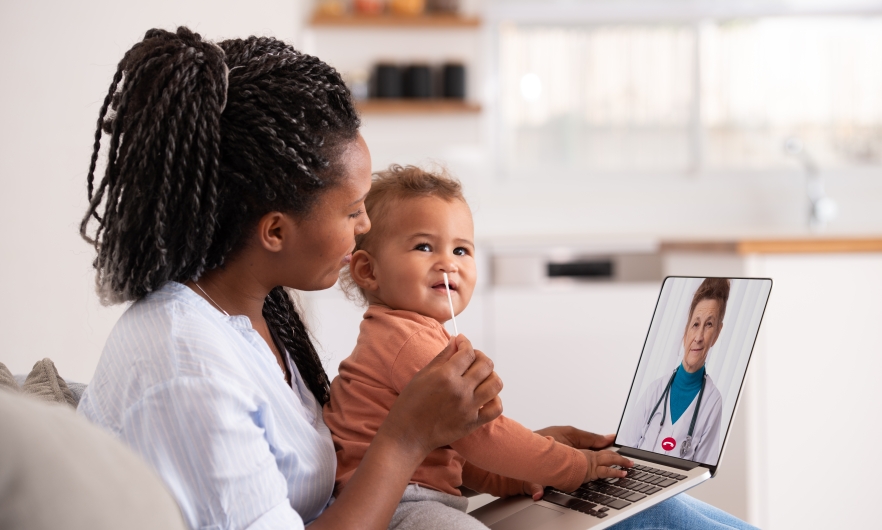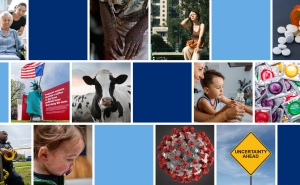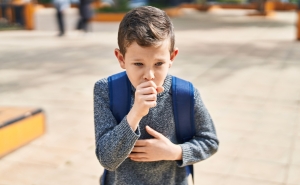Young Children with SARS-CoV-2 Infection Are Frequently Asymptomatic, New Study Finds
SARS-CoV-2 viral load and number of symptoms do not correlate in young children

Young children 0 to 4 years of age are more likely to have asymptomatic SARS-CoV-2 infection compared to adults, but still have lots of virus detectable in their noses, according to a new study by researchers at the Johns Hopkins Bloomberg School of Public Health.
The study, conducted in 175 households throughout Maryland from November 2020 to October 2021, analyzed SARS-CoV-2 infection and associated symptoms in individuals, with a particular focus on young children, a relatively understudied population.
The study was published on August 31 in JAMA Network Open.
The researchers found the most common symptoms in adults were fatigue, nasal congestion, fever, and change in taste or smell. Infected children 0 to 4 years of age, however, were more frequently asymptomatic than adults, and those with symptomatic infection experienced fewer symptoms, most frequently nasal congestion.
While the overall number of symptoms observed correlated with SARS-CoV-2 viral loads in adults, the same was not true for children, who frequently had high viral loads detected even when asymptomatic, suggesting infected asymptomatic children might be able to transmit infection to others. The authors also note that identifying SARS-CoV-2 infection in young children based on symptoms may be more difficult than in adults because the symptoms experienced by these children are indistinguishable from the symptoms of other common respiratory infections.
“Our findings suggest that you should not assume that young children are SARS-CoV-2 negative simply because they show no symptoms,” says Ruth Karron, MD, the study’s lead author and a professor in the Department of International Health at the Bloomberg School. “This is an especially important consideration for parents with children too young to mask who have been exposed to the virus and who may come into contact with older and more vulnerable members of the household.”

This study was part of a household surveillance study, SARS-CoV-2 Epidemiology and Response in Children (SEARCh), aimed at learning more about SARS-CoV-2 infection in young children. It was based in the Department of International Health’s Center for Immunization Research and was a collaborative multidisciplinary effort that included faculty, staff, and students from across the Bloomberg School, including the International Vaccine Access Center (also based in the Department of International Health) and the Department of Environmental Health and Engineering.
SEARCh enrolled Maryland households with 1 or more children aged 0-4 years from November 2020 through March 2021 and followed each household with weekly surveillance for SARS-CoV-2 infection for approximately 8 months. The follow-up period spanned November 2020 through October 2021. SEARCh included 690 participants from 175 households: 256 children ages 0-4 years (including 38 infants under 1 year of age), 100 children between 5 and 17 years of age, and 334 adults 18 to 74.
Household members self-collected weekly nasal swabs to test for SARS-CoV-2 infection and completed weekly questionnaires about illnesses and activities. Participants were recruited through Johns Hopkins Community Physicians, Annapolis Pediatrics, Columbia Medical Practice, and Dundalk Pediatrics. Over 90% of participants completed the planned 8 months of follow-up.
"Without the clinical, epidemiological, and laboratory expertise available in the Department of International Health and across the School, we could not have launched this study, which helps us better understand the experience of SARS-CoV-2 infection in young children and their household members,” says Karron.
This study was conducted during 3 waves of the pandemic, when wild-type, alpha, and delta lineages of SARS-CoV-2 were circulating. While data from Omicron variants was not a part of this study, the researchers believe that findings regarding symptomatology and viral load may also apply to young children infected with Omicron variants. Authors of a related commentary addressing this study’s findings also anticipate similar outcomes with Omicron and future SARS-CoV-2 variants.
The Johns Hopkins University SEARCh Study Team included Maria Deloria Knoll, Chris Heaney, Elizabeth Schappell, Christine Council-DiBitetto, Milena Gatto, Maria Garcia Quesada, Tina Ghasri, Amanda Gormley, Magdielis Gregory Rivera, Kristi Herbert, Marissa Hetrich, Maria Jordan, Kate Kruczynski, Karen Loehr, Jason Morsell, Elizabeth Meyer, Yu Bin Na, Jennifer Oliva, Nora Pisanic, Jocelyn San Mateo, Jayati Sharma, Khadija Smith, Kimberli Wanionek, Cathleen Weadon, Paula Williams-Soro, and Suzanne Woods.
Assessment of Clinical and Virological Characteristics of SARS-CoV-2 Infection Among Children Aged 0 to 4 Years and Their Household Members was written by Ruth A. Karron, Marissa K. Hetrich, Yu Bin Na, Maria Deloria Knoll, Elizabeth Schappell, Jennifer Meece, Erika Hanson, Suxiang Tong, Justin S. Lee, Vic Veguilla, and Fatimah S. Dawood.



